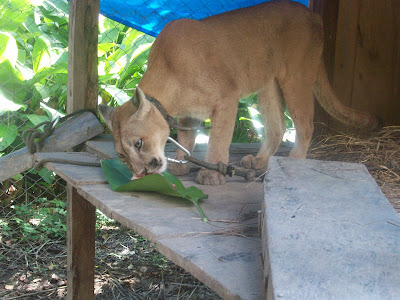An oasis for some, an unfortunately neccesary stop-over for others, La Paz is a city of clashes and contradictions that combined with a potential case of altitude sickness leaves the traveler confused and exhausted. Between the highs ( the mountain of Huayana Potosi peaks at 6024 meters) and the ´highs´of the 24-hour Cocaine dens, there lies a wide realm of the eccentric and curious.
A sign warning what product will be confinscated at random drug search...OR, the recipe for some great Bolivian Yay...
Walk down the ´Witches Market´and you will see dead Llama fetuses, used as a good luck charm when buried under one´s house, or coca-leaf reading fortune-tellers. Coming across Plaza San Pedro, one could never guess this pristine centrally-located square neighbors a major prison. For those who haven´t read ´Marching Powder¨, San Pedro prison is quite unique in its nature- It is so corrupt that some prisoners own ápartments´within the prison, stocked with all the amenities of a modern household, while others freeze to death without a cell. There are restaurants, pool-halls, and the best Cocaine labs in the country. Even more, the children of prisoners are allowed to live within the prison walls, leaving through the front gate every day for school...
For the ´Gringo´trail, La Paz represents a point of leisure. Given the cheap prices, ready availability of supplies natural to a major city, and an entire network deticated to gringos, some find themselves stretching a week stay to several months. For Israelis, La Paz is a chance to buy gifts cheap, and send packages back home. There are several hostels geared towards Israeli travelers as well as a nice selection of places for hummus, falafel, and anything else the mochilero potentially misses. I had proper turkish coffee for the first time in almost half a year, accompanied by a Bolivian attempt at Knafeh...at least they tried.
A semi-regualr sight by the Presidential palace...

Personally, La Paz represented the highway to Gringo-sterility. I seriously believe that some of the travelers who have spent over a month in this City alone haven´t actually ventured from the secure walls of the Irish-themed party hostels. Surely it is their prerogative, but i would ventire to say that if somehow miraculously the ´Gringo hostels´were to be transplanted onto another country...say Uganda for example..I´m not sure the guests would notice, at least for the first week. They will still eat, drink, sleep, party, etc. in the same complex. Sure, the currency would be different, but to many of the travelers here in La Paz its little more than monopoly money...The language would naturally be a bit different as well, but that shouldn´t bother the majority too much, seeing as they haven´t bothered to grasp Spanish either. This is quite a generalization, and I clearly do not mean this about everyone. But you know how much fun stereotyping is, right?

Personally, La Paz represented the highway to Gringo-sterility. I seriously believe that some of the travelers who have spent over a month in this City alone haven´t actually ventured from the secure walls of the Irish-themed party hostels. Surely it is their prerogative, but i would ventire to say that if somehow miraculously the ´Gringo hostels´were to be transplanted onto another country...say Uganda for example..I´m not sure the guests would notice, at least for the first week. They will still eat, drink, sleep, party, etc. in the same complex. Sure, the currency would be different, but to many of the travelers here in La Paz its little more than monopoly money...The language would naturally be a bit different as well, but that shouldn´t bother the majority too much, seeing as they haven´t bothered to grasp Spanish either. This is quite a generalization, and I clearly do not mean this about everyone. But you know how much fun stereotyping is, right?
On a completely different note. Dawn today represents the Winter Solstice, a day of magnificient importance for the Aymara people in Bolivia. Last night We were fortunate to share in the celebrations all night in the ruins of Tiwanaku, about an hour out of La Paz. All-night concerts, dancing and drinking was then followed by a ceremony of ´sun-receiving´. Traditionally, the Aymara would receive the new sun at dawn, arms lanced forward, in order to receive its rays during the frigid morning, and hopefully receive good fortune for the coming years. The night was spent dnacing with others in large circles, communal sharing of drinks (including heated wine, and te con te, which is coca tea and Potable- %96 alcohol), jumping over camp-fires, and keeping warm in -5 degree weather.
The cultural gap, bridged by alcohol...
Jumping that burning ring of fire
The ceremony consisted of raising the Bolivian flag over the ruins of the great temple in Tiwanaku as the sun began to shine. Our view was somewhat limited, yet unfortunately a last-minute plunge into the line of diplomats entering the premises bore new fruit. Apparently I don´t look official enough...The festival was incredible, especially since it was a first real interaction with the local population since i´ve arrived in La Paz.
Receiving the Sun...
With a little help from the sun, the roadblocks leading to Cuzco will disappear by tomorrow and I will be able to make it to the Inca Sun Festival, Intiraymi, set to take place during the night of the 23rd.
Who said Bolivians don´t like israelis?

Last, and assuredly least, I´ve been constantly baggered by fans to upload more photos with my mug in them. Here´s one from back at the camp. More to come...Happy now, Mom and Dad?






















